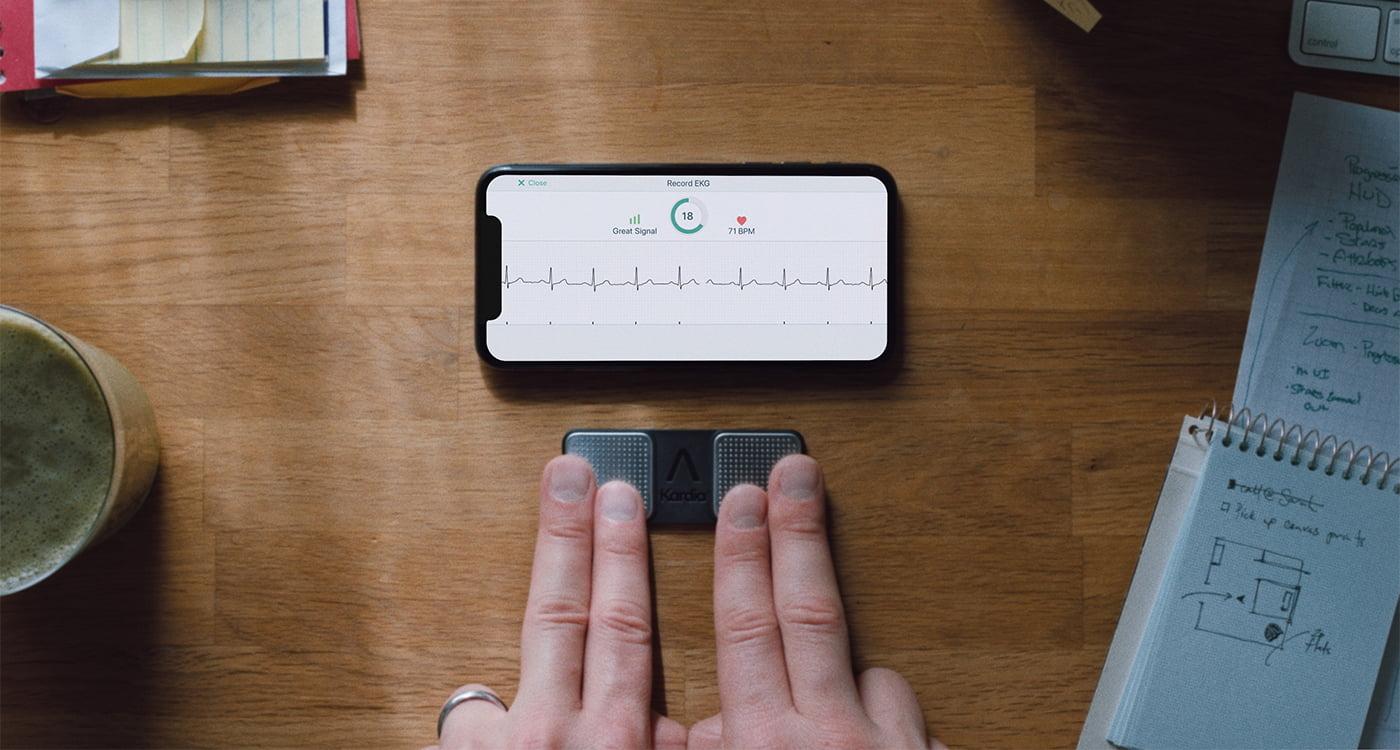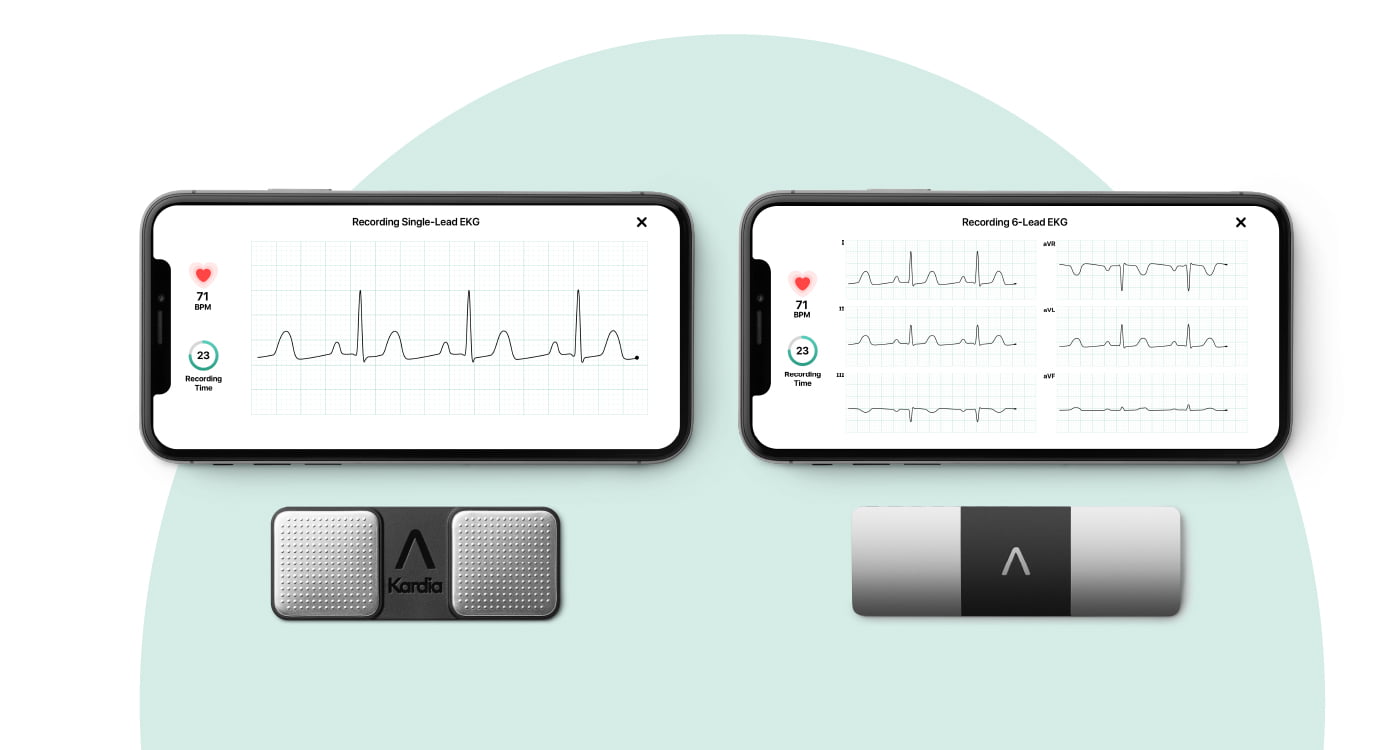In the last few years as technology has improved and become more accessible, many people have started to incorporate at-home EKGs, or personal EKGs, into their health routines. From individuals with heart conditions to athletes monitoring cardio fitness, people from every background have found peace of mind and a more proactive approach to managing their heart health by staying on top of their EKG data. There are various options on the market for individuals who want to track their heart health from home:
-
Apple Watch
The Apple Watch® is a device worn on the wrist that tracks workouts, estimated calories burned, steps walked, and other metrics. According to Apple, “the ECG app on Apple Watch Series 4, Series 5, Series 6, or Series 7 generates an ECG that is similar to a single-lead (or Lead I) ECG.”1 The ECG app can check your recording for irregular rhythms, such as atrial fibrillation, low heart rate, and high heart rate.1 -
Fitbit Sense and Charge 5
Fitbit devices are similar to Apple Watches in that they track various pieces of health data while users wear them throughout the day. Some Fitbit models, Sense and Charge 5, include EKG capabilities as well.2 Fitbit will generate EKG reports in the Fitbit app that outline results as either “Atrial Fibrillation,” “Normal Sinus Rhythm,” or “Inconclusive.” -
KardiaMobile®
KardiaMobile® personal EKGs are designed specifically for the purpose of taking medical-grade EKGs. They are the most clinically validated personal EKG recording devices on the market and the #1 doctor-recommended personal EKG. There are two models of KardiaMobile devices: KardiaMobile, a single-lead (two electrodes) EKG, and KardiaMobile 6L, a six-lead (three electrodes) EKG. Both devices are FDA-cleared to detect up to six of the most common arrhythmias using the Kardia App, including atrial fibrillation, bradycardia, tachycardia, and premature ventricular contractions (PVCs). That’s more than any other personal EKG sensor in the world.
Additionally, KardiaMobile 6L is the only six-lead personal EKG, which provides a more in-depth view of your heart rhythm and may help your doctor identify cardiac arrhythmias such as atrial flutter and heart block.
It's all about what you need
While all these devices share some qualities, like their app-powered user experience, not every personal EKG is quite the same. When picking the one that’s right for you and your lifestyle needs, keep these essential differences in mind.
Arrhythmia detection
While all three of these brands of at-home EKG devices can detect atrial fibrillation within a normal heart rate range, KardiaMobile and KardiaMobile 6L are the only personal EKG sensors that are FDA-cleared to detect six of the most common arrhythmias.
| Apple Watch | Fitbit Sense/Charge 5 | KardiaMobile |
|---|---|---|
| AFib | AFib | AFib |
| Low heart rate | Normal Sinus Rhythm | Bradycardia |
| High heart rate | Tachycardia | |
| Sinus Rhythm | Premature Ventricular Contractions (PVCs) | |
| Sinus Rhythm with Wide QRS | ||
| Sinus Rhythm with SVE | ||
| Normal Sinus Rhythm |
Number of leads
Apple, Fitbit, and KardiaMobile are all single-lead personal EKG sensors (two electrodes). Apple Watch and Fitbit do not offer a six-lead EKG like KardiaMobile 6L. In fact, KardiaMobile 6L is the world’s only six-lead personal EKG sensor and records leads I, II, III, aVL, aVR, and aVF—all without messy wires and gels. KardiaMobile 6L has been found to be more sensitive and more specific than single-lead personal EKGs, providing better data for doctors and patients.3
Detection of AFib at outlier heart rates
KardiaMobile can detect AFib at a wide range of heart rates. However, according to Apple, “a heart rate under 50 BPM or over 120 BPM in ECG version 1 affects the ECG app’s ability to check for AFib. In ECG version 2, a heart rate under 50 BPM or over 150 BPM can affect the ECG app's ability to check for AFib.”1 Fitbit has a similar limitation, namely it cannot assess heart rates below 50 bpm or above 120 bpm.2 This poses an issue for those with atrial fibrillation, which usually occurs in a heart rate range of 100 to 175 bpm.4
Don’t take our word for it…
Hear what customers have to say about KardiaMobile and KardiaMobile 6L.
I bought this a few weeks ago rather than a mainstream watch with an ECG feature and am not looking back! First, at my last Cardiologist appointment the doctor commented on the high quality of the KardiaMobile device and it's readings. He reviewed two weeks worth of readings and answered my questions where I had them. Second, the KardiaMobile devices are significantly less expensive than the mainstream watch with an ECG feature. Yes, a phone is needed, but how often does one travel without their phone these days. I'm thinking about buying a second just to keep in my work/travel bag!
Not to mention the AliveCor customer service team is great! I had a product mix up (error on my end) and they were on it and I was very satisfied with the results.
Ridiculously easy to use and provides accurate information you can use.
Just had a first Afib episode a month ago. I am happy with this purchase as I can take my own reading and understand better what I am feeling and whether I am in Afib or not. Easy to use and set up. I would recommend to those who want to gain control and understanding of their health issues.
Sources:


